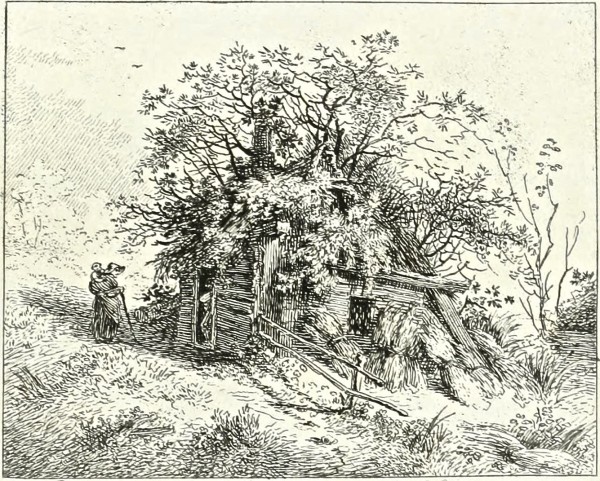John Thomas Smith’s Rural Cottages

Near Battlebridge, Middlesex
As September draws to a close and autumn closes in, I get the urge to go to ground, hiding myself away in some remote cabin and not straying from the fireside until spring shows again. With this in mind, John Thomas Smith’s twenty etchings of extravagantly rustic cottages published as Remarks On Rural Scenery Of Various Features & Specific Beauties In Cottage Scenery in 1797 suit my hibernatory fantasy ideally.
Born in the back of a Hackney carriage in 1766, Smith grew into an artist consumed by London, as his inspiration, his subject matter and his life. At first, he drew the old streets and buildings that were due for demolition at the turn of the eighteenth and nineteenth centuries in Ancient Topography of London and Antiquities of London, savouring every detail of their shambolic architecture with loving attention. Later, he turned his attention to London streetlife, the hawkers and the outcast poor, portrayed in Vagabondiana and Remarkable Beggars, creating lively and sympathetic portraits of those who scraped a living out of nothing but resourcefulness. By contrast, these rural cottages were a rare excursion into the bucolic world for Smith, although you only have to look at the locations to see that he did not travel too far from the capital to find them.
“Of all the pictoresque subjects, the English cottage seems to have obtained the least share of particular notice,” wrote Smith in his introduction to these plates, which included John Constable and William Blake among the subscribers, “Palaces, castles, churches, monastic ruins and ecclesiastical structures have been elaborately and very interestingly described with all their characteristic distinctions while the objects comprehended by the term ‘cottage scenery’ have by no means been honoured with equal attention.”
While emphasising that beauty was equally to be found in humble as well as in stately homes, Smith also understood the irony that a well-kept dwelling offered less picturesque subject matter than a derelict hovel. “I am, however, by no means cottage-mad,” he admitted, acknowledging the poverty of the living conditions, “But the unrepaired accidents of wind and rain offer far greater allurements to the painter’s eye, than more neat, regular or formal arrangements could possibly have done.”
Some of these pastoral dwellings were in places now absorbed into Central London and others in outlying villages that lie beneath suburbs today. Yet the paradox is that these etchings are the origin of the romantic image of the English country cottage which has occupied such a cherished position in the collective imagination ever since, and thus many of the suburban homes that have now obliterated these rural locations were designed to evoke this potent rural fantasy.

On Scotland Green, Ponder’s End

Near Deptford, Kent

At Clandon, Surrey – formerly the residence of Mr John Woolderidge, the Clandon Poet

In Bury St, Edmonton

Near Jack Straw’s Castle, Hampstead Heath

In Green St, Enfield Highway

Near Palmer’s Green, Edmonton

Near Ranelagh, Chelsea

In Green St, Enfield Highway

At Ponder’s End, Near Enfield

On Merrow Common, Surrey

At Cobham, Surrey – in the hop gardens

Near Bull’s Cross, Enfield

In Bury St, Edmonton

On Millbank, Westminster

Near Edmonton Church

Near Chelsea Bridge

In Green St, Enfield Highway

Lady Plomer’s Place on the summit of Hawke’s Bill Wood, Epping Forest

You may also like to take a look at these other works by John Thomas Smith
John Thomas Smith’s Ancient Topography of London
John Thomas Smith’s Antiquities of London
John Thomas Smith’s Vagabondiana
John Thomas Smith’s Vagabondiana II















Totally absorbing. Great fun to draw I’m sure, but some of these would not have been such fun to live in! And how London used to gobble up England. It’s still trying.
Great etchings – beautifully observed and rendered! I found the drawings of Chelsea and Millbank particularly interesting when you consider what it there now. I also agree about the faux cottage style of a lot of suburbs, and wonder how much the horrors of the First World War made people yearn for this rural fantasy?
GA beautiful illustrations shown here today. The poet John Wooderidge lived in one Clandon cottage I expect lots of poems were written here. Poet John, Poetry Soc Bristol
Greetings from Boston,
GA, what a charming collection of rural cottages in John Thomas Smith’s book. So many seem to become part of the surrounding vegetation.
The first one “Near Battlebridge, Middlesex” reminds me of Silas Marner’s cottage just before the Industrial Revolution.
Love these etchings! Firm romantics, we’ve been living in a English cottage facsimile on Galiano Island for the past four years – chopping wood, tending the honeysuckle and roses and wearing lots of cardigans most of the year. That’s me in the last photo, sitting outside our front door watching the robins!
I liked the Hop Cottage but in a good downpour all the rainwater would funnel right into her front door! In fact, some of these homes seem like they would disintegrate with a good rain. I wonder what the inhabitants did to keep dry?
Just shows that for many people the good old days had certain limitations
Lovely to look at and great to live in provided the weather is like Summer 2018. But if it was Summer 2017 – bloody awful. I’m also certain that this style of building didn’t transfer to the Pennines where I now live.